Some tenkara anglers in Japan prefer to tie their sakasa kebari on eyeless hooks. Rather than a metal ring for an eye, these flies have a loop of flexible material to which the tippet is tied. I’ve heard some people say that this connection gives the fly more movement in the water than flies with rigid eyes; however, in my experience, there is little to no difference in the action of eyed vs. eyeless flies. Nonetheless, flies tied on eyeless hooks are unique, beautiful, and can add a fun new dimension to your fly tying.
Eyeless Tenkara Fly Hooks
There are several different brands of eyeless hooks in Japan but many consider Owner and Gamakatsu to be the best. They come in different bends, bronze or blue finishes, and they’re available at Tenkara Bum.
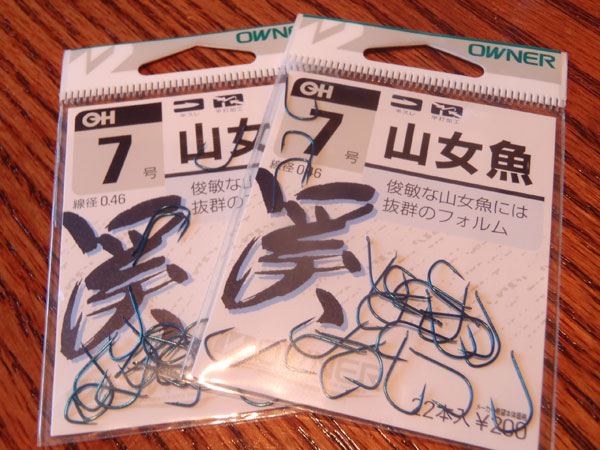
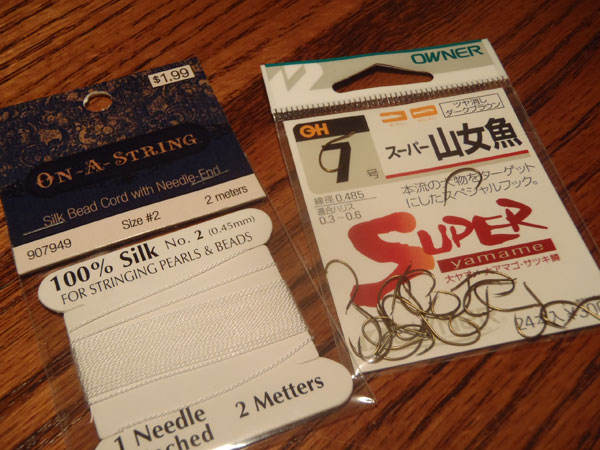
One thing you’ll notice is that Japanese hooks use a different sizing system than we’re used to in the West. Unlike our system where the larger the number, the smaller the hook, it’s the opposite in the Japanese system. So, a #2 is smaller than a #5 (the smaller the number, the smaller the hook). The #7 Owner Yamame hook I used in the fly in the first picture is roughly the same size as the #12 TMC 2499SPBL hooks I often use for my sakasa kebari. The sizing system takes a little getting used to especially considering that different gapes and shank lengths will skew the “true” size of hooks that are labelled the same number.
Loop Eye Material
Some tiers use monofilament or fluorocarbon to create the loop that forms the eye of the fly; however, I prefer the more classic look of slik bead cord. Some have suggested using embroidery floss but it unravels very easily making it difficult to thread your tippet (not to mention creating a sloppy looking fly). Silk bead cord should be relatively easy to find in the jewelry making section of your local craft store but the color choice tends to be limited (usually just white or black). For more color options, I suggest searching eBay. You’ll notice it comes in various sizes and I have found the #2 size to be the best diameter for sakasa kebari.


While many tiers just use the white color, red is also popular. But thanks to a tip from Karel Lansky at Tenkara on the Fly, your color options are only limited by your imagination. He suggests the use of Sharpie markers to color the looping material and while he does it on dacron backing, it also works well on silk cord. For the best results, color a length of cord before you tie the fly and let it dry thoroughly before you use it.

Many tiers like to use a bright, contrasting color for the loop such as red, orange, yellow, chartreuse, or pink, suggesting that it acts as a “hot spot” that is an attractor to fish.
How to Tie a Tenkara Fly on an Eyeless Hook
Now that we’ve looked at hooks and looping material, let’s watch a quick video demonstrating how the silk cord is attached on a very basic fly.
Variations
The video above is just a simple example showing how to tie on eyeless hooks. But of course, you could substitute any combination of materials and colors to create an infinite variety of patterns. Here are a few more examples to get you thinking…
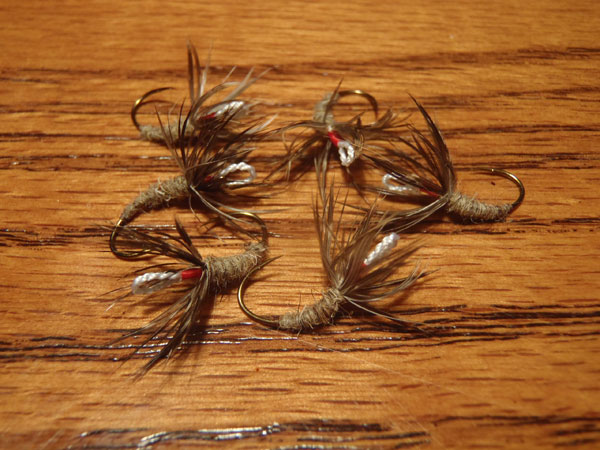
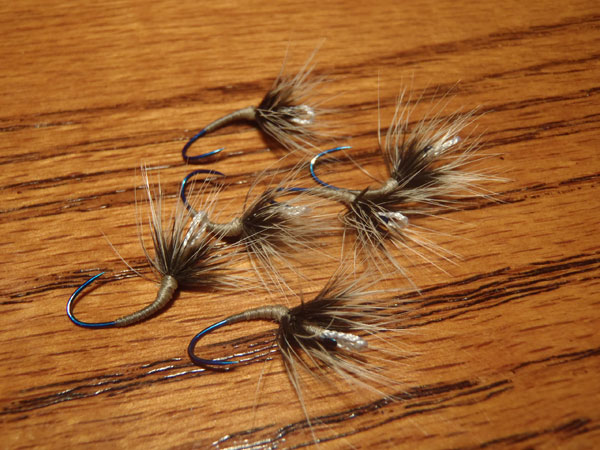


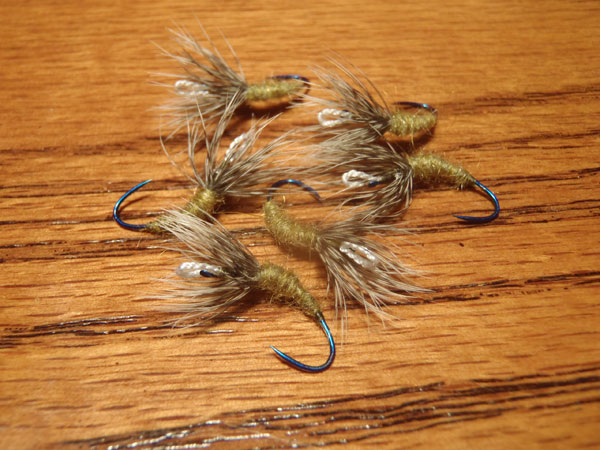
Whether you’d like to start fishing more traditional styles of flies, or just want to try something different in your fly tying, eyeless tenkara hooks offer a good venue to explore your creativity and expand your tying horizon.


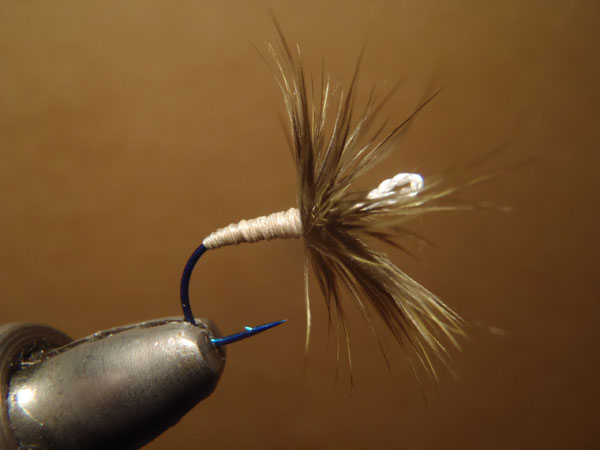






Hi Jason.
I’ll ask as everybody else, how strong is the silk eye, but from a little different angle. On how many trips will you bring a silk eye fly before you have to retire it in fear of it being worn out?
And keep up your blogging. I really appreciate it.
/Stefan
Stefan,
That is a great question and one I am testing now. My guess is that you’d lose the fly first but I will report back if any silk loops break or wear out
Great blog. I have been curious about eyeless hooks, and your post answered a lot of my questions. Now it’s time to order hooks!
I have just recently been tying the eyeless gamakatsu hooks (the weird shaped ones) I have been using 100% Rayon embroidery thread, I unravel the thread and just use one strand. I have fished with them just a little yesterday and today, my stream is pretty blown out but I still caught enough fish to say that rayon holds up for quite some time. of course non of the fish crested about 10 inches or so, and most were in the 6 or 7 inch range, not sure what would happen with bigger fish.
what I want to know is, that video with the guy tying by hand, says he uses “persimmon oil?” to stiffen the thread. I dont know about persimmon oil but I would like to make my eye loop more stiff. after a few fish it gets pretty twisted up, which is fine as long as I dont have to re-rig. one thing I do to help sturdy up the loop is my eye string is tied the full length of the fly. I wrap it on at the head then wrap around it all the way back to the gape then come back and add hackle and fill in the body. I think its less likely to pull out that way, but my string is also much thinner than the one Jason is using.
I will try and add a picture, not sure if it will work on this board.
[url=http://www.flickr.com/photos/45016144@N08/7000589212/][img]http://farm8.staticflickr.com/7190/7000589212_25bf5f5cd3.jpg[/img][/url]
[url=http://www.flickr.com/photos/45016144@N08/7000589212/]IMAG0353[/url] by [url=http://www.flickr.com/people/45016144@N08/]statikpunk[/url], on Flickr
what I want to know is, that video with the guy tying by hand, says he uses “persimmon oil?” to stiffen the thread. I dont know about persimmon oil but I would like to make my eye loop more stiff. after a few fish it gets pretty twisted up, which is fine as long as I dont have to re-rig. one thing I do to help sturdy up the loop is my eye string is tied the full length of the fly. I wrap it on at the head then wrap around it all the way back to the gape then come back and add hackle and fill in the body. I think its less likely to pull out that way, but my string is also much thinner than the one Jason is using.
oh! also, (sorry for being so long winded) the gamakastu hooks I have been using are extremely thin and made from some kind of spring steel, so if they get snagged a good snap of the rod tip seems to dislodge them, I have yet to loose my first eyeless hook and I have gotten it snagged in a couple places that I know would have ended up with a lost fly, or maybe its the weird shape, either way they are great for getting out of snags.
Matt, that’s interesting about the snags pulling out. Karel gave me some very thin wire Gamakatsu hooks but I didn’t like them because they’re kind of annoying to tie on and don’t sink that well (I like heavier hooks). But I never thought about the springiness helping get snags out.
ha! yeah they are absolutely annoying to tie on. after a few you get used to them 🙂
Very nice flies Jason! I really like the looks of the first one.
Very cool, thank you. Thanks for the blog by the way. Tenkara is all new to me and I’m finding it very intriguing, I’ll be trying this for sure! Loving the minimalist approach. Again great site.
Thanks Kelly!
Hi, just wanted to tell you, I liked this blog post. It was inspiring.
Keep on posting!
Just a thought. When taking some flytying classes in Denver many years ago, the following suggestion was made.
Use what ever color thread you use to whip the head/whip finish the fly BUT, whip head and whip finish any weighted fly in red. Easy to recognize weighted flies that way. Just a thought that might apply to the color of the thread used for the eye.
Hi Jason, Thanks for your post and video content here. Was checking for the Owner Yamame Hooks, but was unable to find them on the Tenkara Bum website and on Amazon. Any suggestions for alternate web sources to order these hooks? Also what Size in Fly Tying Hooks Does the Owner Size 7 equate to? I’m guessing a Size #10 Mustad Equivalent? < :-}
Those Owner hooks are hard to find now that Chris isn’t selling them. I’d look on AliExpress or Amazon Japan. I’m going to see if I can source them and make them more widely available. As for the size, as you know, the rating systems are meaningless because there are so many hook shapes now. But, yes, maybe equivalent to a #10 curved hook, or a #12 long shank with a wide gape. But 7 is a good all-around size I’d say. Hope that helps!
Thanks Jason; yes it definitely helped me out with my search for hooks! On Amazon Japan I found a similar style Owner Hook (Owner Shinobu Yamame No. 16598 ). A bit pricey on Amazon JP at > $20+Tax USD (shipping included in the price), but I ordered a pack each of Sizes 5, 6 & 7 for an initial try at tying the Eyeless Tenkara Fly pattern in your You Tube video. I fish for Bluegill quite frequently, so I thought the Size 5 and 6 patterns might be a better fit for that species. Thanks Again. Lots of great Tenkara and Fly Tying content on your website! Cheers! 🙂
I just saw some on Plat: https://www.plat.co.jp/shop/catalog/product_info/language/en/products_id/25571/cPath/5092_3085/tenkara-fly/oh-super-yamame-7-3pcs-set.html